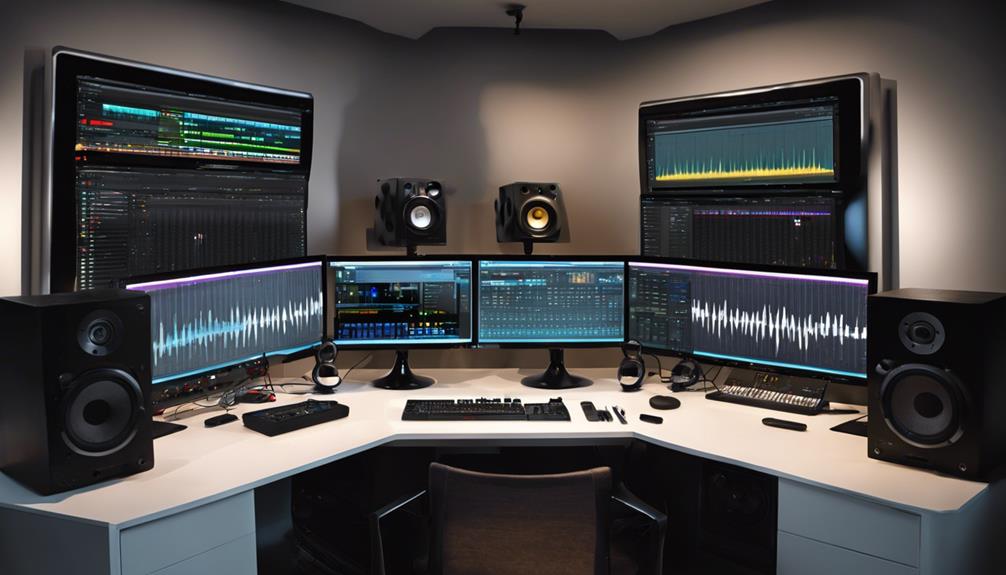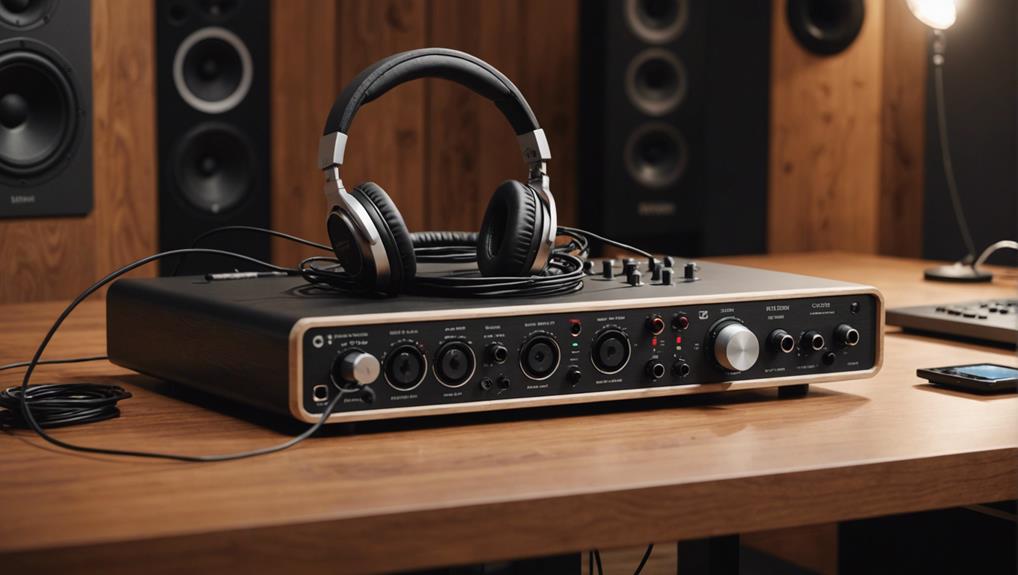No products in the cart.
Mastering rock music transforms your mix into a professional final product by fine-tuning levels, adjusting EQ, and optimizing volume for release. You’ll focus on ensuring track cohesion, removing defects, and aiming for tonal balance and loudness consistency. Before mastering, prepare your mix with at least 1dB of headroom, address phase issues, and fix any frequency imbalances. Essential techniques include enhancing stereo imaging, introducing harmonic excitement, and employing mid-side processing to balance the mix. Avoid common pitfalls like over-compression and incorrect EQ adjustments. Selecting the right software is critical. By mastering these elements, you’ll elevate your rock music to new heights.
Contents
hide
Key Takeaways
- Mastering rock music focuses on fine-tuning levels, EQ adjustments, and optimizing volume for a professional final product.
- Selecting the right mastering software is crucial for applying essential techniques like EQ, compression, and stereo enhancement.
- Preparation involves ensuring at least 1dB of headroom, addressing frequency imbalances, and organizing tracks for efficient mastering.
- Essential techniques include enhancing stereo imaging, applying harmonic excitement, and preventing clipping through careful monitoring and limiting.
- Avoid common pitfalls like over-compression, phase issues, incorrect EQ adjustments, and the masking effects of saturation or distortion.
Understanding Mastering Basics
Mastering stands as the critical final step in preparing your rock music for release, focusing on fine-tuning levels, EQ adjustments, and optimizing volume to achieve a polished and cohesive sound. This phase is paramount in transforming a good mix into a professional final product. Your mastering workflow should begin with a clear understanding of the tasks at hand: removing defects, ensuring track cohesion, and applying metadata for a professional presentation. Each action within this workflow is targeted at enhancing the overall mix, maintaining the track’s character while aiming for tonal balance, loudness consistency, and clarity.
When diving into mastering software options, you’re faced with a plethora of choices, each offering unique tools for EQ, compression, limiting, and stereo enhancement. These are essential in achieving the desired gel and cohesiveness in your rock music. Software options range from industry-standard suites to more specialized tools that allow for finer adjustments and creative control. Incorporating additional processing, such as exciters, saturation, or de-essing, can add color and address any lingering issues, elevating your music’s quality. Selecting the right mastering software is critical in realizing your vision for the final product, making an informed choice integral to your mastering strategy.
Preparing Your Mix for Mastering
Before sending your mix for mastering, it’s vital to make sure it has at least 1dB of headroom to prevent clipping during the mastering process. This initial step is an important part of your mastering preparation, guaranteeing that the master engineer has the necessary space to work effectively.
During your mix evaluation, pay close attention to phase issues. These can lead to comb filtering and compromise mono compatibility, which are crucial in maintaining the integrity of your rock music across various playback systems. Identifying and addressing any frequency imbalances or harshness is equally essential. Such issues can detract from the listening experience, making your track sound less professional.
Properly labeling and organizing your tracks can greatly streamline the mastering process. This level of preparation helps avoid confusion and ensures that your vision for the track is clearly communicated to the mastering engineer.
Essential Mastering Techniques
To achieve a polished sound in rock music, it’s vital to fine-tune levels, EQ, compression, and stereo width meticulously. You’ll need to lean on several advanced techniques to guarantee your rock music masters have the energy, depth, and clarity they deserve. Specifically, focusing on stereo imaging, harmonic excitement, mid-side processing, and clipping prevention will elevate your mastering skills.
- Stereo Imaging and Harmonic Excitement: Enhancing the stereo field while carefully introducing harmonic excitement adds depth and brings life to your tracks. This technique assures that each element within the mix occupies its own space, making the overall sound fuller and more engaging.
- Mid-Side Processing: This allows you to treat the center and sides of a stereo image separately. By applying EQ and compression differently to the mid and side channels, you can achieve a more balanced mix, with clear, punchy centers and wide, open sides.
- Clipping Prevention: It’s essential to monitor peak levels and employ soft clipping or limiting to prevent digital distortion. This guarantees your master remains dynamic and powerful without sacrificing audio quality.
Incorporating these critical mastering techniques will help you create dynamic, compelling rock music masters that stand out.
Common Mastering Pitfalls
While perfecting your rock music masters, it’s essential to avoid certain pitfalls that can greatly detract from the quality of your final product. Over-compression is a common mistake that can kill the energy and dynamics of your mix. It’s vital to maintain a balance, guaranteeing the music retains its natural punch and transients without squashing its life force.
Phase issues, particularly in multi-mic recordings, can notably undermine your mastering efforts. You must verify for coherence, as misalignment can lead to a thin or hollow sound, robbing your track of its fullness and impact.
Be careful with EQ adjustments. Incorrect application can introduce muddiness or excessive harshness, detracting from the clarity and definition of the instruments. Each adjustment should enhance the mix’s overall balance without compromising its sonic integrity.
Lastly, watch out for masking effects when applying saturation or distortion, especially in heavily distorted sub-genres. These effects, while intended to add richness and body, can inadvertently obscure critical frequencies, leading to a cluttered and unintelligible mix. Managing these aspects carefully will ensure your rock music master shines in its intended glory.
Selecting the Right Mastering Tools
After understanding common mastering pitfalls, it’s vital to focus on selecting the right mastering tools that cater specifically to the unique demands of rock music. The mastering chain for rock music requires a careful blend of precision and creativity, ensuring each track not only stands out but also cohesively fits within the album.
To enhance your mastering workflow, consider these plugin recommendations:
- Multiband Compression: Essential for controlling different frequency ranges, offering the flexibility needed to address the dynamic range without compromising the energy of rock tracks.
- Tape Saturation Emulation: Adds warmth and character, a sought-after quality for achieving that classic rock sound. It’s crucial for mixing tips that aim to preserve the grit and authenticity of rock music.
- Stereo Widening: While ensuring mono compatibility, this tool can significantly expand the soundstage of your mix, making the rock tracks feel larger than life.
Moreover, don’t overlook plugins that feature exciter options to boost presence and color, and those with advanced limiting capabilities for achieving competitive volume levels. Integrating these tools into your mastering chain won’t only refine your sound but also elevate your overall production.
Frequently Asked Questions
How Do You Master a Rock Track?
To master a rock track, you’ll adjust dynamic range and EQ balance, applying subtle saturation for warmth. Use multiband compression for frequency control and preserve transients for clarity. Focus on stereo imaging for a wide sound.
How Do You Master a Song for Beginners?
To master a song, you’ll adjust EQ techniques and compression settings precisely. Start with broad EQ adjustments, then fine-tune. Use compression to balance dynamics without squashing them, ensuring a polished, professional sound.
At What Db Should Beat Be Before Mastering?
Before mastering, you should keep your beat’s mixing levels at around -6dB to maintain a balanced dynamic range. This prevents clipping, ensuring the track’s clarity and allowing effective mastering adjustments.
How Loud Should a Rock Master Be?
Your rock master should aim for -9 to -6 LUFS, ensuring it’s loud yet maintains dynamic range. Use precise metering techniques to balance loudness with clarity, avoiding over-compression for best punch and energy.
Conclusion
In summary, mastering your rock music tracks is essential for achieving a polished, professional sound. By preparing your mixes with care, employing key mastering techniques, and avoiding common pitfalls, you’ll enhance your tracks’ sonic qualities.
Selecting the right tools is key to applying precise adjustments and achieving clarity, depth, and balance in your music. Remember, mastering is both an art and a science, requiring an analytical approach to fine-tune your tracks for the best listening experiences across various platforms and devices.







